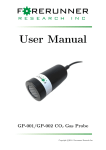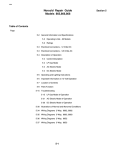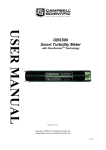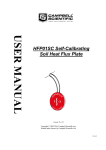Download User Manual - Forerunner Research Inc.
Transcript
User Manual GP-001/GP-002 CO2 Gas Probe c Copyright 2015. Forerunner Research Inc. This page intentionally left blank. 2 This guide is distributed by FORERUNNER RESEARCH INC (“Forerunner”) for users of the GP-001 or GP-002 Gas Probe instruments in conjunction with the FRConnectGP software. Forerunner is not liable for special, indirect, incidental, or consequential damages. Forerunner’s obligation under this warranty is limited to repairing or replacing (at Forerunner’s discretion) defective products. The customer shall assume all costs of removing, reinstalling, and shipping defective products to Forerunner where applicable. Forerunner will return said products by surface carrier prepaid. This warranty is in lieu of all other warranties, expressed or implied. DISCLAIMER: Please check the GP CO2 Gas Probe Product page on the Forerunner website (http://www.forerunnerresearch.ca/) for the most up-to-date manual. REV: April 3, 2015 3 GP001/GP002 and FRConnect-GP User Manual Contents 1 Introduction 2 Hardware 2.1 Overview . . . . . . . . . . 2.2 Membrane Integrity . . . . 2.3 CO2 Measurement . . . . 2.4 Main Power & Data Cable 2.5 Power Connectors . . . . . 2.6 Data Cable . . . . . . . . 2.7 Ground Connector . . . . 6 . . . . . . . 7 7 7 7 9 10 10 11 3 FRConnect-GP User Interface 3.1 Setup and Connection . . . . . . . . . . . . . . . . . . . . . . . . . . . . 3.2 Using the Interface . . . . . . . . . . . . . . . . . . . . . . . . . . . . . . 13 13 13 4 User Calibration 15 5 Logged Datafiles 17 6 Troubleshooting 18 . . . . . . . . . . . . . . . . . . . . . . . . . . . . . . . . . . . 4 . . . . . . . . . . . . . . . . . . . . . . . . . . . . . . . . . . . . . . . . . . . . . . . . . . . . . . . . . . . . . . . . . . . . . . . . . . . . . . . . . . . . . . . . . . . . . . . . . . . . . . . . . . . . . . . . . . . . . . . . . . . . . . . . . . . . . . . . . . . . List of Figures 1 2 3 4 5 6 7 8 9 10 11 12 13 SSC Main Power & Data Cable . . DC+ Power Cable . . . . . . . . . Data Cables . . . . . . . . . . . . . Ground Connector . . . . . . . . . Attach ground connector to SSC. . Connect SE wires and ground wires FRConnect-GP Main Window . . . FRConnect-GP Data Options . . . FRConnect-GP Plotting Options . Flow-through Header . . . . . . . . User Calibration Dialog . . . . . . Two-point calibration curve . . . . Sample FRConnect-GP data file . . . . . . . . . . . . . . . . . . . . . . . . . . . . . . . . . . . . . . . . . . to datalogger. . . . . . . . . . . . . . . . . . . . . . . . . . . . . . . . . . . . . . . . . . . . . . . . . . . . . . . . . . . . . . . . . . . . . . . . . . . . . . . . . . . . . . . . . . . . . . . . . . . . . . . . . . . . . . . . . . . . . . . . . . . . . . . . . . . . . . . . . . . . . . . . . . . . . . . . . . . . . . . . . . . . . . . . . . . . . . . . . . . . . . . . . . . . . . . . . . . . . . . . . . . . . . . . . . . . . . . . . . . . . . . . . . 9 10 11 11 11 12 13 14 14 15 15 16 17 List of Tables 1 2 Example scaling for single ended voltage outputs on the GP 001/002 sensors. 9 Sample two-point calibration data. . . . . . . . . . . . . . . . . . . . . . 16 5 1 Introduction This manual outlines the operation and features of the GP-0011 /GP-002 Carbon Dioxide (CO2 ) Probes, as well as the FRConnect-GP software package. Before providing power to the GP please ensure that you read the section on Power Connectors to avoid any damage to the sensor. We strongly recommended that all users read the complete manual before use. The Hardware section explains the physical attributes of the GP and its accessories. The FRConnect-GP User Interface section explains the Windows-based software that is used to communicate with the gas probes in order to record data and adjust logging parameters. The following Logged Datafiles section explains the structure and formatting of the datafiles recorded by FRConnect-GP, as well as what each field represents. A Troubleshooting section briefly covers some possible issues that may arise during normal operation of the software. For further information or assistance, please contact [email protected] or visit the Forerunner website (www.forerunnerresearch.ca). 1 Please note, GP-001 discontinued as of 09/30/2014. 6 2 2.1 Hardware Overview The GP sensor housing is constructed using a highly-durable acetal (Polyoxymethylene) housing, which has many advantages for field-use, such as high abrasion resistance and low water absorption. The housing is cylindrical with a diameter of 51 mm and a length of 107 mm (120 mm including the electrical connector). Forerunner’s NDIR CO2 sensor is enclosed in the acetal housing, and is exposed to gases through a membrane which covers the face of the GP housing. This membrane material allows gas transport to the sensor, but does not allow any intrusion of liquid water. GP-001 sensors are guaranteed to be waterproof to 1 m of water column, whereas GP-002 sensors are waterproof to up to 3 m of water column. The waterproofing of the sensor requires that users do not open the GP housing. A tamper-evident seal is placed on the GP housing to prevent intentional or accidental loosening of the cap. Any tampering with the cap will void the warranty on the GP and its components. 2.2 Membrane Integrity The GP membrane is critical to proper operation of the device. The membrane should always appear uniform in colour and free from visible defects. It is important to periodically check the membrane, as use in field conditions may cause it to tear or otherwise become defective. If the membrane appears to be compromised, it is critical that the GP not be submerged in water. If you have any concerns about the GP membrane please contact Forerunner for support. When using the GP to monitor CO2 concentrations in water columns deeper than 1 m, users should ensure that they both slowly lower the sensor into the water and slowly extract the sensor after the monitoring period. Rapid submersion or extraction in deep (>1 m) water causes rapid pressure changes in the sensor and can compromise the membrane seal and allow water to leak into the sensor housing. A submersion/extraction timespan of approximately 15 minutes in 3 m of water should be sufficient to avoid this problem. 2.3 CO2 Measurement The GP series of sensors measure gas concentration using non-dispersive infrared (NDIR) sensing, which correlates light source intensity to a specific gas concentration. The GP001/GP-002 sensors offer a CO2 concentration measurement accuracy of ±1% of full scale, with a repeatability of ±1% of reading. The GP CO2 concentration readings are automatically corrected for changes in temperature, and can also be compensated for changes in atmospheric pressure using the ideal gas law correction: C∗ = C × Pref Pi where C is the raw concentration, Pref is the reference pressure (101.35 kPa) and Pi is the pressure measured in the field (in kPa). This correction may be applied to data collected via the FRConnect-GP software by modifying the pressure in the main interface (See section 3.2 for more information). For voltage-based concentration measurements, the data must be corrected in post-processing. For applications where high accuracy is important, Forerunner recommends that users periodically check the calibration of their sensors by exposing them to known concentration standards. This is necessary as 7 NDIR sensors can drift over time due to natural changes in the electrical and mechanical properties of the sensor components. 8 2.4 Main Power & Data Cable The GP-001/GP-002 ships with a standard 5 m long power and data cable (SSC) which plugs directly into the 12-pin socket on the GP housing. Figure 1 shows the SSC Power & Data Cable. Ensure that the notch on the SSC connector is aligned with the tab on the 12-pin GP socket, push to seat the connector on to the socket and hand tighten the connector. Power is supplied to the GP via the two pin connector on the oppoFigure 1: SSC Main Power & Data Cable site end of the SSC. This connector also has a tab and notch type system to ensure that the user connects power with the correct polarity. The GP may be powered by supplying a regulated voltage to the sensor via data logger, battery or other power supply device. Please see the section entitled Power Connectors for more details. Sensor data, including CO2 concentration and sensor temperature measurements can be accessed by two methods: 1. The first is by using the 3-pin Data connector on the SSC, combined with the Serial Extension Cable (Fig. 3a) to connect to a PC on which the FRConnect-GP software is installed. This connection may be made directly to a serial port via the Serial Extension Cable, or to a USB port via a USB-Serial Converter (Fig. 3b). The FRConnect-GP software can then be used to read the data from the sensor (please see the section entitled FRConnect-GP User Interface for more information on using FRConnect-GP). 2. Alternatively, the sensor output can be accessed using the single ended (SE) voltage outputs at the end of the SSC. Three wires provide signals corresponding to lowrange CO2 concentration (Purple), high-range CO2 concentration2 (Gray) and sensor temperature (Blue). All outputs are scaled from 0-5 V, but each voltage signal may correspond to a different range for concentration and temperature, depending on the sensor calibration. An example of typical values is shown in Table 1. Please note that the scaling factors will be affected by calibration ranges and the user should be aware of their sensor specific calibration. Parameter Low-range CO2 Concentration High-range CO2 Concentration Temperature Voltage 0-5 0-5 0-5 Range V V V Actual Range 0→5000 ppm 0→20000 ppm -20◦ C→50◦ C Table 1: Example scaling for single ended voltage outputs on the GP 001/002 sensors. 2 High-range calibration values available only with optional dual calibration. With single range calibrated devices, Gray SE wire is auxiliary (e.g. CO2 alarm, CO2 concentration deviation, etc). 9 The equations below show an example calculation of CO2 concentration from an assumed single ended voltage reading (SEV) of 2 V: SEV=2 V 2 V/5 V=0.4 0.4*5000 ppm = 2000 ppm Please note that unless a specific temperature calibration was requested, the range for temperature is -20◦ C to 50◦ C. Finally, the optional 10 m cable (SLC) has the same configuration and outputs as the SSC. 2.5 Power Connectors The power supply cable included with the GP 001/002 sensors allows for powering the sensor using a DC power supply (DC+). Figure 2 shows the DC+ external power cable. The cable includes a 2pin connector for attachment to the SSC/SLC cables. The opposite end of the cable has tinned wire ends, to allow for connection to any DC power supply. The black wire should be attached to the ground terminal of the DC power device, and the red wire should be attached to the positive terminal. The GP can operate on DC power ranging from 5-24 V, with 12 V being the standard voltage used during calibration and testing. Exceeding 24 V will damage the GP, please ensure that the voltage is regulated correctly before connecting the power supply to the GP. 2.6 Figure 2: DC+ Power Cable Data Cable Digital communication between FRConnect-GP and a GP-001/GP-002 uses the RS-232 Serial protocol. The following components may be used to facilitate this interface. • GP Data/Power Cable (Fig. 1) - (Included ) Used to power a GP-001/GP-002 as well as provide an RS-232 interface. • Serial Extension Cable (Fig. 3a)- (Included ) Connects the GP Data cable to a standard 9-pin serial port or USB-Serial converter. • USB-Serial Converter (Fig. 3b) - (Optional ) Used to create a virtual comport, allowing the GP Data cable to be connected to a computer through a USB port. 10 (a) Serial Extension Cable (b) USB-Serial Converter Figure 3: Data Cables 2.7 Ground Connector Included in the GP-001/GP-002 package is a ground connector for use with Campbell R Scientific dataloggers. Figure 4 shows the ground connector. When the GP is connected to the Campbell R Scientific datalogger through the single ended voltage ports and both units are powered using a single power source, an apparent square wave bias may be present in the datalogger output. This square wave has a period of approximately 120 minutes, and has an amplitude of 5-20 mV. Figure 4: Ground Connector This distortion can be removed in one of two ways: by powering the datalogger and GP separately, or by sampling the data using a differential voltage measurement. To create a differential voltage measurement: 1. Plug the ground connector into the 3-pin connector on the SSC/SLC (Fig. 5). Figure 5: Attach ground connector to SSC. 11 2. Each differential voltage port on the datalogger has three inputs labeled H, L, and G. In the H side of the port, insert the signal wire from the GP (blue, purple, or gray). In the L side of the port, insert one of the black wires from the new ground connector(Fig. 6). Figure 6: Connect SE wires and ground wires to datalogger. 3. Configure the datalogger program to read differential voltage measurements using the VoltDiff command (please refer to your data logger user manual for more information). 12 3 FRConnect-GP User Interface 3.1 Setup and Connection FRConnect-GP requires no installation on the part of the user. Simply download the file “FRConnect-GP.zip” from the GP CO2 Gas Probe product page on the Forerunner website (http://www.forerunnerresearch.ca/) and save to a suitable directory on the PC in question; then, unzip3 the file (which contains one folder titled “FRConnect-GP”). None of the files in this folder should be removed or changed in any way. If this occurs, simply remove the entire folder from your PC and re-extract from the zip file to recreate the folder. The program executable is labeled “FRConnect-GP.exe”4 , and double clicking this icon or a Desktop Shortcut will launch the program. It is recommended that you connect the USB data cable to your computer prior to launching FRConnect-GP; however you may also refresh the program from the Options menu. The port on which the GP is connected will likely be the only choice available (Options⇒ComPort⇒COM#), however you may have to refer to the device manager if several serial port devices are connected to the computer. Once the port is selected, a connection to the gas probe will be created. 3.2 Using the Interface Figure 7 shows the FRConnectGP interface. The interface has three main areas: the logging options; the current reading and start/stop controls; and the plotting area. The top section shows the currently selected datafile/frequency and the specified external pressure value (used to correct gas concentrations). These settings can be modified via the change buttons situated on the right, or from the menubar. The middle section shows the current CO2 concentration reading, and allows the user to start and stop logging/plotting. It also shows how long the current logging session has been running. Clicking the Start button will enable FRConnectGP to start collecting measureFigure 7: FRConnect-GP Main Window ments from a connected GP-001 or GP-002, and to both plot and log this data. Note that the plot will show every individual measurement, while the datafile will contain averages over an interval specified by the user. Once a session has been started, clicking the Stop button will stop FRConnect-GP from recording measurements from the gas probe. The plotted values will remain until the Start button is used again, at which point the plot will be reset. 3 If your computer lacks decompression software, 7zip is a suitable free utility for handing archive files computer may be set to hide the .exe extension 4 Your 13 The bottom section contains a plot of recent concentrations over the chosen time interval. This interval defaults to 15 minutes, but can be changed using the radio buttons at the bottom. If the collected data exceeds this interval, then only the most recent points will be shown. There are several secondary plotting options available in Options⇒Plotting Options, including the ability to toggle between an automatic and fixed scale for the Y-axis. To start collecting data, first choose a location to save logged data by clicking the Change button across from the “Logging to:” line, or by choosing File⇒New Log File. Select or create a CSV file using the Open File window. Please note that if the selected file already exists, new data will be appended at the end of the file with a new Figure 8: FRConnect-GP Data Options header line. Once you have chosen a save file the Data Options window will appear. Choose the desired formatting options and which fields to log from the Data Options window as shown in Figure 8. For GP units equipped with the optional dual range calibration, the range can be toggled from the Options⇒Plotting Options window as shown in Figure 9. To plot data using the high calibration range check the box next to ”Use High-Concentration Calibration?” Click the Start button to begin logging data. In addition to being stored in the selected file, a plot of the CO2 concentration measurements is shown in the FRConnect-GP window. Figure 9: FRConnect-GP Plotting Options 14 4 User Calibration For applications where high accuracy is important, Forerunner recommends that users periodically check the calibration of their sensors by exposing them to known concentration standards. This is necessary as NDIR sensors can drift over time due to natural changes in the electrical and mechanical properties of the sensor components. The exact concentrations of the gases used to perform the calibration are not of particular importance, so long as the values are known. It is preferable that the standard gases span the exFigure 10: Flow-through Header pected range of operation and fall within the original calibrated range of the sensor. Users can use more than two standard gases for calibration; however, the correction curve fit through multiple points must be linear. Any higher-order fits (i.e. quadratic) are likely to lead to significant error outside the calibration range. To perform the calibration, expose the GP to each standard gas until the sensor equilibrates (typically 10-15 minutes is sufficient). A flow rate of less than 1 SLPM is desirable, as higher flow can cause increased ambient pressure which will affect the concentration calibration. The Forerunner flow-through header (Figure 10) may be used for this procedure, though it is often sufficient to flow gas into a bag containing the sensor. Record the quoted concentration of the standard as well as the measured values from the GP. To incorporate this calibration into data collected using FRConnect-GP, open the Options ⇒User Calibration window. Input your calibration points and click Okay. This operation saves your calibration within the software, so you do not need to re-enter the calibration parameters each time you open the software. Please note, this does not hard-code the parameters to your unit. If you have multiple instances of FRConnect-GP recording data from various units you will need to input the correction factor that correlates with the particular unit for each instance. If you wish to use a datalogger, you will need to correct your data in post-processing or within the data logger program. To correct data collected using a datalogger, plot the standard versus the reported concentrations and calculate a linear best-fit equation. Use this best-fit equation as the transform for your data as required. Figure 11: User Calibration Dialog Sample data from a two-point calibration is shown in Table 2. Figure 12 shows the corresponding graph. The best-fit line, shown in Figure 12, may then be used to transform collected data. 15 Standard (ppm) 0 970 Measured (ppm) -15 940 Table 2: Sample two-point calibration data. Figure 12: Two-point calibration curve 16 5 Logged Datafiles The measurement data file is formatted as a comma separated values file (.csv) by default, allowing for easy importing into spreadsheet or plotting software. Figure 13: Sample FRConnect-GP data file Each of the possible data fields in the output file are listed below, with a brief description of what that value represents. Timestamp The timestamp for the line of data. The default format is “MM/DD/YYYY HH:MM:SS”, with the option of changing to seconds since start of session. CO2 Low The average CO2 concentration over the interval using the lowrange calibration (ppm). CO2 Low SD The standard deviation of CO2 Low during the interval (ppm). CO2 High The average CO2 concentration over the interval using the highrange calibration (ppm). CO2 High SD The standard deviation of CO2 High during the interval (ppm). CO2 Low Raw The average CO2 concentration over the interval using the lowrange calibration ignoring user corrections (ppm). CO2 Low Raw SD The standard deviation of CO2 Low Raw during the interval (ppm). CO2 High Raw The average CO2 concentration over the interval using the highrange calibration ignoring user corrections (ppm). CO2 High Raw SD The standard deviation of CO2 High Raw during the interval (ppm). Temp The average of the internal sensor temperature over the interval (◦ C). Temp SD The standard deviation of internal sensor temperatures measured during the interval (◦ C). Samples The number of samples that occurred during the interval. 17 6 Troubleshooting This section provides a few example problems that may occur during use, and the appropriate action that should be taken to resolve the issue. For these issues as well as any others that arise, please contact Forerunner Research Inc. at 1-902-870-5220, or by emailing us at [email protected]. • The GP does not seem to be outputting serial data (using FRConnect-GP) or SE voltages Please ensure that the power supplied to the GP is between 5 and 24 VDC. • FRConnect-GP does not show or log any data. Ensure that the gas probe is connected to power and that a session has been started (via the Start button in FRConnect-GP). Check that the correct ComPort has been selected under Options⇒ComPort. If the problem persists, exit FRConnect-GP, disconnect and then reconnect the USB data cable, then re-launch FRConnect-GP. • No ComPorts show up under Options⇒ComPort Ensure that the gas probe is connected to power. Open the device manager from the Control Panel in Windows and reconnect the USB data cable. If no connections show up under Ports (Com & LPT), please contact Forerunner for further instruction. • The GP socket/cable is oxidizing/discolouring when used in water In environments which have higher than normal levels of salt or other ions, the GP socket and/or cable may oxidize or discolour. This will not affect the measurement performance, but will shorten the lifetime of the sensor. In these types of environments we recommend attaching the cable to the GP probe and then lightly coating the metal components with silicone grease (i.e. high-vacuum grease). Coating with silicone grease is also advisable in waterlogged soils. • S.E. voltage outputs vary with power supply type/voltage The S.E. voltage wires output 0 V to 5 V signals that correspond to the current CO2 and temperature readings in the sensor. These outputs can be monitored as an alternative to receiving digital data. If the GP is powered independently of the device which is logging the S.E. voltages, then the S.E. voltage may change with varying power supplies even if the gas concentration or temperature has not changed. It is critical that the device which is logging the S.E. voltages and that providing the power for the GP have the same ground. For example if using a commercially available data logger to log the S.E. voltage, also use the 12 V power supply port that exists on the data logger. • GP readings are abnormally noisy The GP sensor requires a stable power supply with minimal noise in order to achieve the lowest possible noise on concentration and temperature measurements. When using the GP, ensure that the power supply is of high quality or that the power supply variation is buffered with an in-line battery or other power smoothing device. If you are unsure about your power supply setup please contact Forerunner. • GP readings are off from my laboratory standard Forerunner makes all efforts to ensure accurate calibration, including periodic checks against NIST traceable standards, however calibrations may vary from individual laboratory standards. There are several reasons for this, including long term sensor drift, changes in atmospheric pressure (sensors are calibrated at sea-level) and variation in gas supplier analysis techniques. We highly recommend that users concerned with comparing GP results with other laboratory and field instrumentation re-calibrate GP sensors using the same standards, and/or cross calibrate all instruments. 18 NOTES: 19 NOTES: 20 Forerunner Research Inc. 1 Research Drive Dartmouth, Nova Scotia Canada, B2Y 4M9 Phone: 1.902.870.5220 Fax: 1.902.466.6889 Email: [email protected]





























